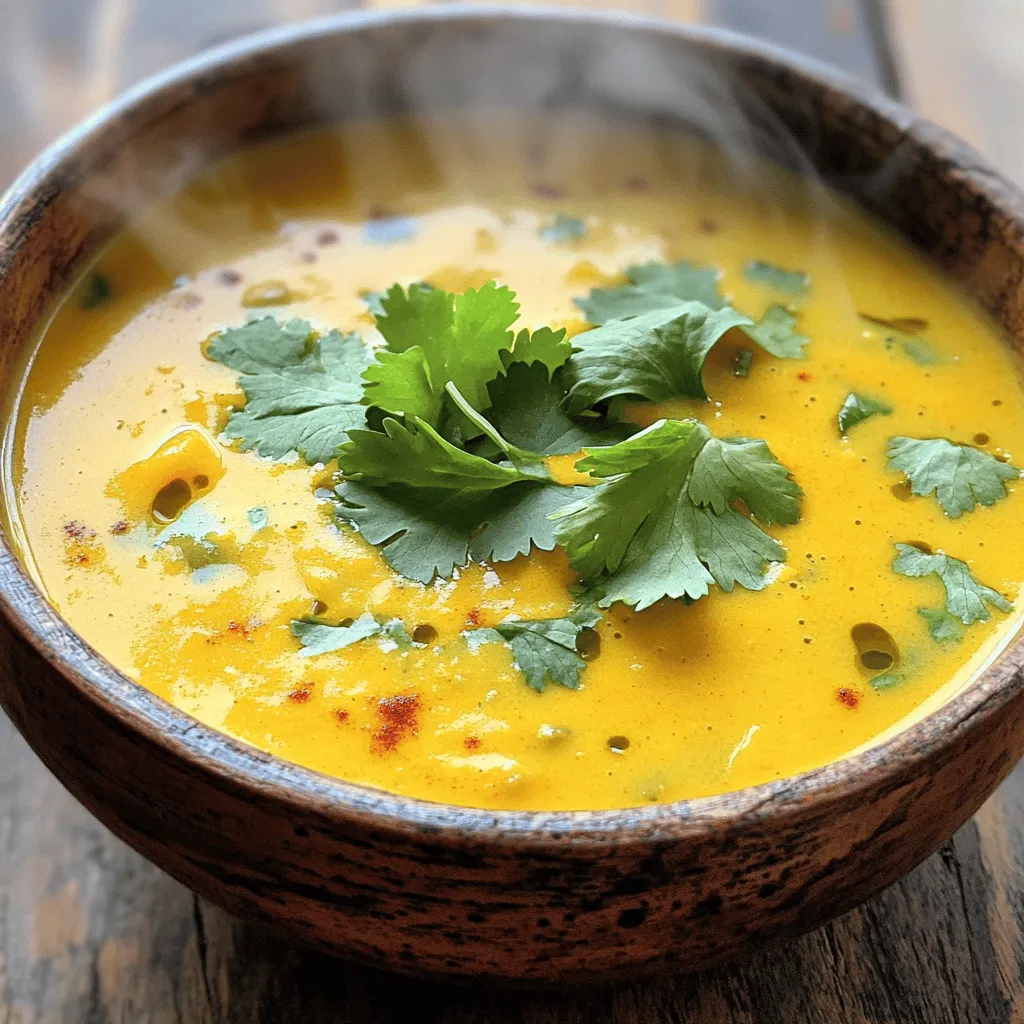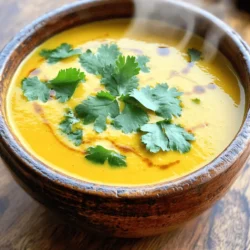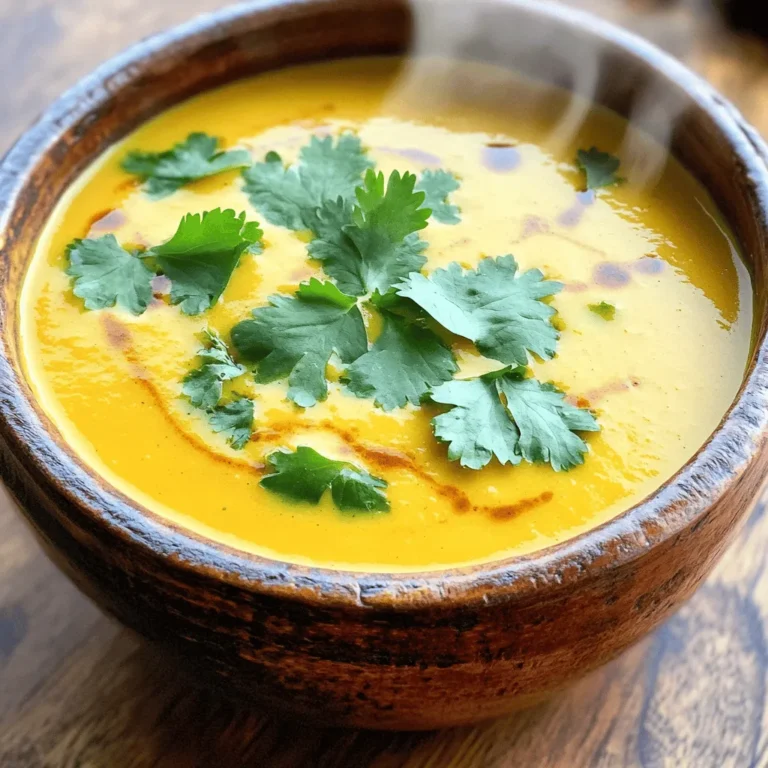Warm, creamy, and packed with flavor, Coconut Curry Butternut Soup is a delight. This nourishing dish combines sweet butternut squash with rich coconut milk and bold spices. Whether you’re seeking comfort food or a healthy meal, this soup is a win. In this post, I’ll share the ingredients, step-by-step instructions, and tips to make it perfect. Get ready to enjoy a bowl of happiness that warms you from the inside out!
Ingredients
Detailed List of Ingredients
To make Coconut Curry Butternut Soup, gather these simple ingredients:
– 1 medium butternut squash, peeled and diced
– 1 tablespoon olive oil
– 1 onion, chopped
– 3 cloves garlic, minced
– 1 tablespoon fresh ginger, grated
– 2 tablespoons red curry paste
– 4 cups vegetable broth
– 1 can (14 oz) coconut milk
– 1 tablespoon maple syrup (optional for sweetness)
– Salt and black pepper to taste
– Juice of 1 lime
– Fresh cilantro leaves for garnish
Ingredient Substitutions
If you don’t have something on hand, here are some easy swaps:
– Butternut squash: You can use sweet potatoes or pumpkin instead.
– Olive oil: Feel free to use coconut oil for a richer flavor.
– Red curry paste: Try yellow curry paste if you want a milder taste.
– Vegetable broth: Chicken broth works if you prefer a non-vegetarian version.
– Coconut milk: Use almond milk or cashew cream for a lighter option.
– Maple syrup: Honey can replace it if you like.
Notes on Fresh vs. Canned Ingredients
Using fresh ingredients gives the best flavor. Fresh butternut squash has a nice texture and taste. Peel and dice it before cooking. Canned coconut milk offers convenience and creaminess. It saves time and still tastes great. If you choose fresh garlic and ginger, your soup will have more vibrant flavors. For garlic and ginger, use minced fresh instead of powdered for the best results.
Step-by-Step Instructions
Preparation Steps
To start, gather all your ingredients. You need:
– 1 medium butternut squash, peeled and diced
– 1 tablespoon olive oil
– 1 onion, chopped
– 3 cloves garlic, minced
– 1 tablespoon fresh ginger, grated
– 2 tablespoons red curry paste
– 4 cups vegetable broth
– 1 can (14 oz) coconut milk
– 1 tablespoon maple syrup (optional for sweetness)
– Salt and black pepper to taste
– Juice of 1 lime
– Fresh cilantro leaves for garnish
First, peel and dice the butternut squash. Use a sturdy knife. It can be tough to cut, so take your time. Next, chop the onion and mince the garlic. Grate the ginger too. This mix of flavors will be the base of your soup.
Cooking Instructions
In a large pot, heat the olive oil over medium heat. Once hot, add the chopped onion. Sauté for about 5 minutes until the onion is soft and clear. Then, add the minced garlic and grated ginger. Cook for 1-2 minutes. You want to smell those amazing scents!
Next, add the diced butternut squash to the pot. Stir in the red curry paste. Make sure all the squash gets coated. Pour in the vegetable broth and bring everything to a boil. Once boiling, lower the heat, cover the pot, and let it simmer for about 20-25 minutes. This helps the squash get tender.
Blending to Achieve the Right Texture
After simmering, remove the pot from heat. It’s time to blend! If you have an immersion blender, use it directly in the pot. Blend until the soup is smooth. If you don’t have one, carefully transfer the soup to a regular blender. Blend in batches if needed.
Once blended, pour the soup back into the pot. Now, stir in the coconut milk and maple syrup if you want a touch of sweetness. Season with salt, black pepper, and lime juice to taste. Warm the soup on low heat for about 5 minutes to let the flavors mix well.
Serve your soup hot! Garnish with fresh cilantro leaves on top. Enjoy this warm, creamy delight.
Tips & Tricks
How to Perfect Your Coconut Curry Butternut Soup
To make your soup shine, start with fresh ingredients. Use a ripe butternut squash for a sweet base. Peel and dice it evenly so it cooks well. Sauté the onions until they are soft. This step builds a rich flavor.
When adding garlic and ginger, stir gently. Let them cook until fragrant but not brown. This helps keep their bright flavors. Use a good quality red curry paste. It adds depth and warmth.
Blend the soup until smooth but not too thin. You want a creamy texture. If it’s too thick, add a bit more broth.
Enhancing Flavor Profiles
To enhance the soup, try adding a splash of lime juice. It brightens the dish and balances the curry’s heat. You can also add a tablespoon of maple syrup for sweetness. This gives a nice contrast to the spices.
Fresh herbs are key! Garnish with cilantro for a fresh finish. You can also add a pinch of cayenne pepper for heat.
Common Mistakes to Avoid
One common mistake is overcooking the butternut squash. If it’s too soft, it can lose its flavor. Watch the cooking time.
Another mistake is not blending enough. Make sure it’s smooth. Chunks can ruin the creamy feel.
Lastly, be careful with salt. Always taste before adding more. You can always add, but you can’t take away!

Variations
Adding Protein Options
You can easily add protein to your Coconut Curry Butternut Soup. Some great choices are cooked chicken, shrimp, or chickpeas.
– For chicken: Use shredded rotisserie chicken for a quick option.
– For shrimp: Add peeled, deveined shrimp during the last few minutes of cooking.
– For chickpeas: Add a can of drained chickpeas for a hearty vegan option.
These proteins will make your soup more filling and nutritious.
Vegetarian and Vegan Adaptations
This soup is already vegetarian and can be vegan with a few tweaks.
– Use vegetable broth to keep it vegetarian.
– Ensure your red curry paste is vegan. Some brands add shrimp paste.
– Skip the maple syrup if you want a savory soup.
By making these changes, you can enjoy a tasty and plant-based version.
Flavoring Variations (Spices and Herbs)
Changing spices and herbs can take your soup to new levels.
– Add a pinch of cumin for warmth.
– Try turmeric for a vibrant golden color.
– Fresh basil or mint can add a refreshing twist.
These simple tweaks will enhance the flavor and keep your soup exciting every time you make it.
Storage Info
How to Store Leftovers
Once you finish your meal, let the soup cool down. Pour it into an airtight container. This helps keep the soup fresh. Store the container in the fridge. The soup will stay good for up to five days. Always check for any signs of spoilage before eating.
Freezing Tips
If you want to save the soup for later, freezing is a great option. Use a freezer-safe container or a zip-top bag. Leave some space at the top because soup expands when it freezes. Label the container with the date. The soup can last for up to three months in the freezer. When you are ready to eat, just thaw it in the fridge overnight.
Reheating Instructions
To reheat, pour the soup into a pot. Heat it on medium until it’s hot. Stir it often to avoid sticking. If the soup is too thick, add a splash of water or broth. You can also use a microwave. Place the soup in a microwave-safe bowl. Heat it for one minute at a time, stirring in between. Enjoy your warm, tasty soup!
FAQs
How Long does Coconut Curry Butternut Soup last?
Coconut curry butternut soup lasts about 4-5 days in the fridge. Store it in an airtight container. Make sure it cools down before you put it in the fridge. When you want to eat it, just reheat on the stove. Stir it well to blend the flavors again.
Can I use fresh butternut squash instead of frozen?
Yes, you can use fresh butternut squash instead of frozen. Fresh squash gives a great taste and texture. Just peel and dice it into small pieces. The cooking time remains the same. Fresh squash helps to keep the soup vibrant and tasty.
Is it possible to make this soup in a slow cooker?
Yes, you can make this soup in a slow cooker. Just add all the ingredients to the slow cooker. Set it on low for 6-8 hours or high for 3-4 hours. Blend the soup when it’s done cooking. This method allows the flavors to deepen and meld nicely.
In this post, we explored key ingredients for coconut curry butternut soup. We covered details on substitutions and the choice between fresh and canned items. The step-by-step instructions made preparation and cooking simple. I shared tips to enhance flavors and avoid common mistakes. You can even adapt the recipe with proteins or spices. Finally, we discussed storage and reheating. With this guide, you can enjoy a delicious soup that’s easy to make and full of flavor. Dive in and enjoy your cooking journey!


